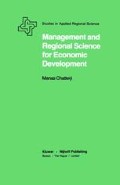Abstract
The starting point of any analysis of economic development is, of course, population. Before we discuss the issues involved with regional population growth and its projection, a region itself needs to be defined.
Access this chapter
Tax calculation will be finalised at checkout
Purchases are for personal use only
Preview
Unable to display preview. Download preview PDF.
References
References
Airov, Joseph. 1963. “The Construction of Interregional Business Cycle Models.” Journal of Regional Science 5, no. 1:1–20.
Chatterji, Manas. 1972. “The Future of Regional Science.” Northeast Regional Science Review 2:1–4.
Choudhury, M. D. 1966. Regional Income Accounting in an Underdeveloped Economy. Calcutta: Asia Publishing House.
Deane, Phyllis. 1953. Colonial Social Accounting. Cambridge: Cambridge University Press.
Elderton, William D., and Johnson, N. L. 1969. Systems of Frequency Curves. Cambridge: Cambridge University Press.
Hirsch, Werner, ed. 1964. Regional Accounts for Policy Decisions. Baltimore, Md.: Johns Hopkins University Press.
Hochwald, Werner, ed. 1961. Design of Regional Accounts. Baltimore, Md.: Johns Hopkins University Press.
Isard, Walter. 1960. Methods of Regional Analysis. Cambridge, Mass.: MIT Press
Leven, Charles L. 1958. “Theory and Method of Income and Product Accounts for Metropolitan Areas.” Mimeographed, Iowa State College, Ames.
Rees, P. H., and Wilson, Alan G. 1974. Spatial Demographic Analysis. New York: Wiley Interscience.
Rogers, Andrei. 1968. Matrix Analysis of Interregional Population Growth and Distribution. Berkeley: University of California Press.
Wilson, Alan G. 1974. Urban and Regional Models in Geography and Planning. New York: Wiley.
Bibliography
Bourland, D. D. 1950. “The Distribution of Progressions within Cities in the United States.” American Journal of Psychology 63: 244–249.
Champernowne, D. G. 1953. “A Model of Income Distribution.” Economic Journal 63:318–351.
Chatterji, Manas. 1963. “Studies in the Structure of the Calcutta Economy.” Docterol dissertation, University of Pennsylvania, Philadelphia.
Chatterji, Manas. 1966. “Municipal Costs and Revenues in the Calcutta Industrial Region.” Quarterly Journal of Local Self-Government Institute (Bombay) 36, no. 3, issue 143 (January—March).
Chatterji, Manas. 1969. “A Model of Resolution of Conflict between India and Pakistan.” Papers of the Peace Research Society 12 (November): 87–102.
Committee on National Statistics. 1980. Estimating Population and Income of Small Areas. Washington, D.C.: National Academy Press.
Hirsch, Werner, ed. 1962. Elements of Regional Accounts. Baltimore, Md.: Johns Hopkins University Press.
Mandelbrot, B. 1965. “A Class of Long-Tailed Probability Distributions and the Empirical Distribution of City Sizes in Mathematical Explorations in Behavioral Sciences.” In Fred Massarik and Philburn Ratosh, eds., Mathematical Explorations in Behavioral Science. Homewood, I11.: Irwin.
Simon, H. A. 1955. “On a Class of Skew Distribution Functions.” Biometrika 42:425–440.
Wolfenden, Hugh H. 1954. Population Statistics and Their Compilation. Chicago: University of Chicago Press.
Zipf, George Kingsley. 1949. Human Behavior and the Principle of Least Effort. Cambridge, Mass.: Academy-Wesley Press.
Author information
Authors and Affiliations
Rights and permissions
Copyright information
© 1983 Kluwer-Nijhoff Publishing
About this chapter
Cite this chapter
Chatterji, M. (1983). Analysis and Projection of Population and Income. In: Management and Regional Science for Economic Development. Studies in Applied Regional Science, vol 22. Springer, Dordrecht. https://doi.org/10.1007/978-94-009-7412-8_2
Download citation
DOI: https://doi.org/10.1007/978-94-009-7412-8_2
Publisher Name: Springer, Dordrecht
Print ISBN: 978-94-009-7414-2
Online ISBN: 978-94-009-7412-8
eBook Packages: Springer Book Archive

